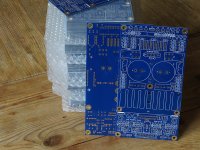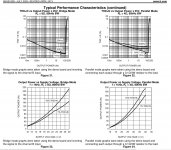The pcb's will turn up on Friday if the plan can be kept. You can still sign up for more, see my sig below.
just wondering can the PA03 in monoblock mode drive a 4 ohm 200~250W speaker.
I am confuse between the parallel mode (120W 2 ohm) and bridge mode(120W 8 ohm) of pA03. I am assuming bridge mode can pumps out more current.
I am confuse between the parallel mode (120W 2 ohm) and bridge mode(120W 8 ohm) of pA03. I am assuming bridge mode can pumps out more current.
If you start with two 60W into 4ohms amplifiers, you have three choices:
a.) power two 4ohms speakers independently and you get 60W+60W into 4+4ohms, equals a total of 120W
b.) arrange the two amplifiers in parallel so that they are able to deliver twice the current at the same voltage. You now get 120W into 2ohms.
c.) arrange the two amplifiers in bridged format so that they deliver the same current at twice the voltage. You now get 120W into 8ohms.
Note that for all three options, the total power delivered from any combination is 120W. All the amplifiers deliver the same maximum voltage and deliver the same maximum current, since they are the same amplifiers.
Which option you choose depends on the capability of the amplifier and the impedance of your speaker/s.
a.) power two 4ohms speakers independently and you get 60W+60W into 4+4ohms, equals a total of 120W
b.) arrange the two amplifiers in parallel so that they are able to deliver twice the current at the same voltage. You now get 120W into 2ohms.
c.) arrange the two amplifiers in bridged format so that they deliver the same current at twice the voltage. You now get 120W into 8ohms.
Note that for all three options, the total power delivered from any combination is 120W. All the amplifiers deliver the same maximum voltage and deliver the same maximum current, since they are the same amplifiers.
Which option you choose depends on the capability of the amplifier and the impedance of your speaker/s.
Last edited:
Just for clarity, Andrew:
Option a.) ... power TWO [my emphasis] 4 ohms speakers ...
Option b.) ... power ONE speaker ...
Option c.) ... power ONE speaker ...
Option a.) ... power TWO [my emphasis] 4 ohms speakers ...
Option b.) ... power ONE speaker ...
Option c.) ... power ONE speaker ...
Yes! 🙂
Per-Anders
Can i order two "blue" PA03? I Signed wiki as CestmirD.
Regards
CestmirD
@CestmirD, yes. A Paypal invoice is already sent.
@sagitis The LM4780 chip is mainly made for 2 channels and the main drawback is limited cooling abilities. The part consists of two LM3886 chip so if you want to take out more power it probably would be better to use two LM3886.
@sagitis The LM4780 chip is mainly made for 2 channels and the main drawback is limited cooling abilities. The part consists of two LM3886 chip so if you want to take out more power it probably would be better to use two LM3886.
(...)
Note that for all three options, the total power delivered from any combination is 120W. All the amplifiers deliver the same maximum voltage and deliver the same maximum current, since they are the same amplifiers.
Which option you choose depends on the capability of the amplifier and the impedance of your speaker/s.
Theoretically yes, but I think in real life, around 100W total output will be maximum. The 2x60W in 8ohm is using 35V power supply, and 0,5% THD - so on the ragged edge you might say..
PerAnders recommends using 33V DC (24VAC x 1,41 and rounded off) as maximum to avoid excessive heat dissipation from LM4780.
Also I get the impression from TI datasheet, that even 33V is too much if bridging. See attached excerpt from page 14. As I read it, if you want to bridge, it is best to stay around 25V (unless your speakers are very high impedance, like 10-16 ohm), and for parallel use around 33V (and max 35V) is ideal.
So it would be best to decide the mode of operation before buying transformer. And the deciding factor here, is the loudspeaker impedance curve: If it is 8 ohm or higher (without significant dips) bridging can work well, but else parallel configuration is better. If you want to keep all options open, use 25-26V PS. All in my humble opinion, and more experienced people may know better.
Attachments
Recommendation for PA03 volume potentiometer (non inverting operation)
Hi all,
what would the recommended impedance of a volume potentiometer for the PA03 in non onverting mode look like? I plan to use PA03 directly driven from a line level source without pre amp.
PA03 input impedance: 20k.
From my own limited experience I would have chosen a value smaller than 20 k but have seen that people use the PA03 directly driven with potentiometers up to 50 k in non inverting mode.
Any hints?
Thanks in advance!
Christoph
Hi all,
what would the recommended impedance of a volume potentiometer for the PA03 in non onverting mode look like? I plan to use PA03 directly driven from a line level source without pre amp.
PA03 input impedance: 20k.
From my own limited experience I would have chosen a value smaller than 20 k but have seen that people use the PA03 directly driven with potentiometers up to 50 k in non inverting mode.
Any hints?
Thanks in advance!
Christoph
If you want a non-inverting buffer the inimpedance could be megaohms especially if you have a JFET opamp. As it is now a 10 k pot will work although not 100% optimum.
I know for sure I've seen it somewhere, but now I can't find the informations about the L1-2.How many turns those should have and if the value is critical.
Thank you
Thank you
Hi,
I real something about 15 turns, 1.3 to 1.4 mm diameter wire, 8 mm inner diameter.
Christoph
I real something about 15 turns, 1.3 to 1.4 mm diameter wire, 8 mm inner diameter.
Christoph
@asuslover, if you look in the BOM, you have it there.
15 turns with 1.3 mm wire is right and the diameter could be from 6 to 8 mm. It's not critical.
15 turns with 1.3 mm wire is right and the diameter could be from 6 to 8 mm. It's not critical.
- Home
- Group Buys
- Pavel Dudek's super Gainclone group buy

